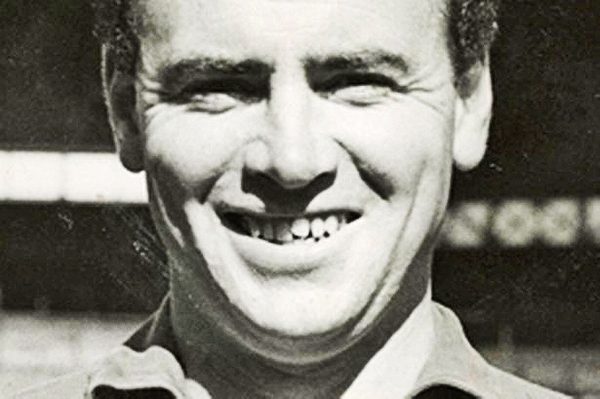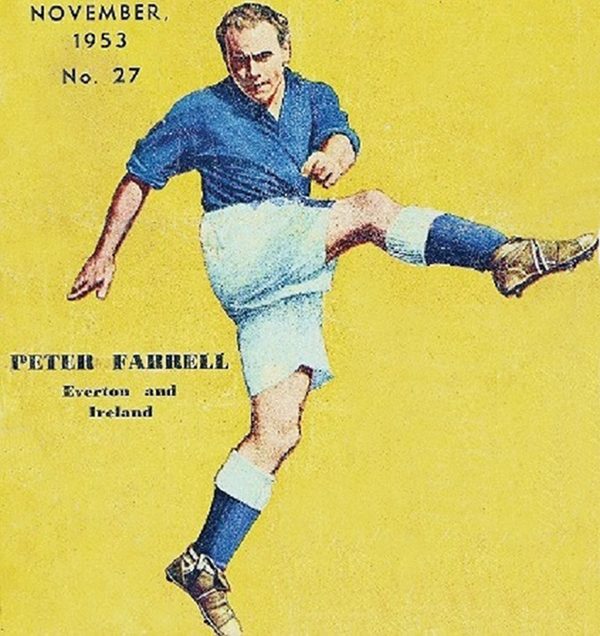
Pictured above: Peter Farrell in his heyday.
Peter Farrell was probably Irish football’s greatest ever wing-half. The wing-half was defined as a midfield player stationed near the side of the pitch, but that doesn’t begin to show how important to the team a good wing-half was in defence and attack, like Peter Farrell, “a tireless worker who thrived on one-to-one situations and never shirked a tackle.”
He was born in Dalkey in 1922 and played youth football with Cabinteely, then signed with Ringsend’s Shamrock Rovers on his seventeenth birthday. He went straight into the first team and played in three consecutive FAI Cup finals from 1944 to 1946. These performances got him noticed by Everton FC who signed him in July 1946.
Farrell was already an international player by then, having made his Republic of Ireland debut, as captain against Portugal in June 1946. He became a regular for the Republic and also played seven times for Northern Ireland. His best performance for them was in 1947 against England. He gave a peerless display of man-marking against England and The Irish Times reported that he “stuck to his man like a burr”. Nobody got past him that day, and the resulting draw earned the Irish their first undefeated season since 1914.
Farrell often produced such fine midfield performances for the Republic of Ireland team, and he could also do the business from a forward position.
This adaptability helped him seal one of the greatest results in the history of Irish football when, playing up front, he scored in the 2-0 win away to England in September 1949. That victory secured the Republic’s place in history as the first ‘foreign’ team to inflict a home defeat on England.
In October 1949, the Irish team was in Helsinki to play a World Cup qualifier against Finland. Ireland were in dire need of a good result and Farrell was picked as a forward again, scoring in a 1-1 draw which meant Ireland could qualify for the 1950 World Cup if they beat Sweden in Dublin. Against the Swedes, Farrell played up front for the third consecutive game but couldn’t score and Ireland were beaten. In the next international he was back in midfield, in his element.
At Everton, from his first match, he thrived in the hard midfield areas. He was energetic and aggressive, but played fair, and the club’s fans remember him as “tough, but never dirty”.
Everton were relegated in 1951, but Farrell was loyal to the club through those few dismal seasons, and skippered the club back to Division One in 1954. He was in his thirties by then, still going strong and looking like he could stay there for many years to come. But when his good pal Tommy Eglington left Everton in June 1957, it wasn’t long before Farrell followed.
Farrell and Eglington had been friends and teammates for a long time, they’d been at Shamrock Rovers with each other back in the 1940s, joined Everton together and made their international debuts in the same match. And, when Eglington was gone from Everton, it just wasn’t the same.
So Farrell left Everton, having played 421 games in his eleven seasons with them. Supporters from his time there, who said they had been “privileged to watch him play” testify that Everton’s fifth round FA Cup match against Manchester United on the 14th of February 1953 is “the one match Everton fans will always remember him for.”
At the time Everton had spent nearly two years enduring Division Two football but they were on an upward trend, and the team was on a good run of form as United came calling that Valentine’s Day.
But the visitors hadn’t come bearing flowers and chocolates and, within 30 minutes, they had scored. There was no let-up from United and it looked like they would soon make it two-nil. But, as the Liverpool Echo reported, “Peter Farrell, by judicious touches with his head and feet rescued his side in some critical moments.” And, as halftime approached, the tables were turned when Tommy Eglington equalised.
In the second half United kept attacking but Everton defended manfully with the Echo again praising Farrell for “doing excellent work”. When Everton scored on the counter-attack just after the hour, it seemed to incite United into greater efforts and, in the last twenty minutes, the Reds pushed relentlessly forward and it looked like just a matter of time before they broke through in “a last desperate effort to force an equalizer.”
United were right on top towards the end and “came within a whisker of breaking through,” but “it was Farrell to the rescue again to clear,” and Everton held fast until the final whistle sounded when they celebrated a famous victory against the champions of England. Old-time supporters of Everton said that it was “the finest show they ever put up.”
With performances like that, it was no wonder they loved Farrell at Everton. The club and its fans never wanted him to leave for Tranmere in 1957, but go he did. And he wasn’t going just to take it easy, he was made club captain and played 114 games for the club in three seasons.

Pictured: Peter Farrell Everton and Ireland.
Farrell was famously popular, and in Liverpool he has a street named after him, Farrell Close. It is near Goodison Park, where they’ll always remember the Dubliner who ran the show in Everton blue.
Back home, we have the stories of his time in the green shirt to keep his name alive as a hero of Irish football. Every time we play England, the spirit of 1949 returns and a new generation hears of Peter Farrell’s glorious Goodison goal.
For Rovers, Everton and Ireland, he never stopped battling. Maybe football has forgotten what a wing-half was, but it won’t forget Peter Farrell the Ireland great.
By Gavan Bergin



